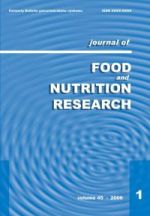Scientific journal
Journal of Food and Nutrition Research
Online First Articles
Jiang, Y. – Sun, Q. – Xiao, P. – Hao, Y. – Zhang, T. – Chu, Z.
Residues and risk exposure assessment of 6-benzylaminopurine for bean sprouts in Shandong, China
Zunhua Chu, Shandong Center for Disease Control and Prevention, Shandong Academy of Preventive Medicine, Shandong First Medical University School of Public Health, Jingshi Road 16992, 250014 Ji’nan, China. E-mail: shipinyuyingyang@163.com
Qing Sun, Children’s Hospital Affiliated to Shandong University, Jingshi Road 23976, 250022 Ji’nan, China. E-mail: cyansq@163.com
Original article
Received 23 May 2024; 1st revised 6 August 2024; accepted 8 October 2024; published online 23 January 2025.
Summary: 6-Benzylaminopurine (6-BAP) is an important ingredient in production of “toxic bean sprouts”. In order to assess health risk from 6-BAP residue in bean sprouts on a large sample size and wide sample range among large survey population, 6-BAP was detected in 149 out of 1494 bean sprouts samples collected in 2016–2020 in Shandong Province of China. High performance liquid chromatography-tandem mass spectrometry was used for analysis. Those 10.0 % samples contained 6-BAP residue above the maximum residue limit (MRL) and the average level was 0.007 mg·kg-1. Hazard quotient (HQ) of 6-BAP was 0.0 % for the general population and 0.2 % for consumers. The daily exposure of 6-BAP was accounted for 0.0 % of the the acceptable daily intake (ADI) and the estimated daily intake (EDI) of all subjects surveyed was below ADI. From the perspective of public health, the occurrence of 6-BAP residue in bean sprouts could not pose a serious health risk problem. Strict regulations on the management of 6-BAP residue in bean sprouts and human health risk assessment should be recommended.
Keywords: risk exposure assessment; plant growth regulator; acceptable daily intake; chronic intake risk assessment; public health
Download:
(pdf, 335.76 Kb, 230x)










